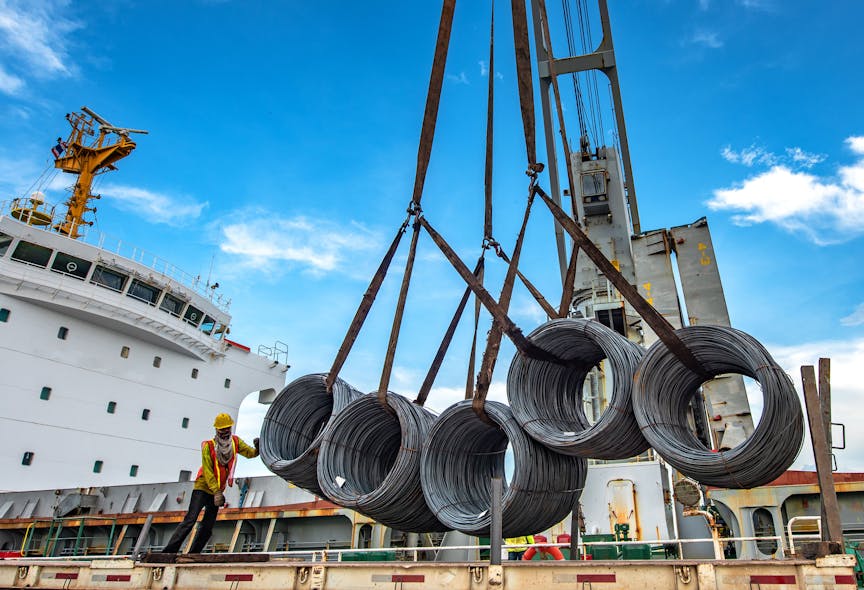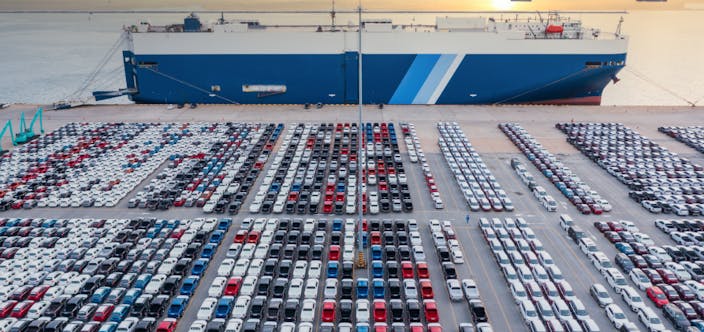Steel Cargo: Understanding the risks helps reduce the occurrence of damage
Steel cargo is high value but challenging to handle and transport because it is easily damaged, and depending on its form, it can be difficult to secure. To help to mitigate the risks this article addresses some of the main considerations regarding loading and carriage of steel cargoes and provides some helpful reminders and best practices.

Check the condition of the cargo prior to loading
Properly assessing the condition of the cargo prior to loading is vital. Steel cargo comes in many different forms and types/grades. Some types, such as stainless-steel cargoes, are extra sensitive and easily subject to deformation, indentation, scratches, and need to be protected against surface friction to avoid scuffing. It is key to know the state of the cargo prior to loading and its specifics in order to adequately protect its condition.
When steel cargoes have already suffered mechanical damage or rusting that has not been identified and recorded in the Mate’s Receipts and the Bill of Lading (discussed in more detail in the final paragraph), any damage which is found later during the discharge of cargo will be presumed to have happened onboard. It is the responsibility of the Shipowner to ensure that the cargo is delivered in the same condition that it was loaded.
Ensure hold cleanliness
Hold cleanliness plays a big part in maintaining the condition of the cargo. If the hold is not properly prepared for the cargo, it can result in delays, disputes, and damage claims. When inspected prior to loading, the hold must be found clean and dry; free from saltwater residue or dry salt, and there should be no trace of previous cargoes. The carriage of steel cargo is not limited to holds, for example it may also be carried in containers and on MaFi trailers onboard Ro-ro vessels. Suitable precautions should be taken to avoid contamination regardless of the type of vessel carrying the steel.
Handle steel cargo properly
During loading there is a risk that poor handling will cause damage to the cargo and/or the vessel structure. Incorrect methods of slinging, improper use of lifting gear, and inappropriate use of forklifts can all lead to mechanical damages of the steel which may result in the cargo being rejected by the consignee. If it is possible to use a forklift fitted with round tines, this is strongly advised. A log should be kept of all activities; How the cargo arrived at the berth, what the weather conditions were, if the stevedores were using the correct lifting equipment and methods, observations regarding the use of dunnage, the times when the hatches were opened and closed, and the condition of the cargo. Incorrect loading of the steel often leads to vessel damages, so paying close attention at this stage of operations is crucial. The Master has the overall responsibility for ensuring that the ship is seaworthy.
Stow and secure steel cargoes correctly and avoid overloading
It is important to always consult your company’s instructions for the safe carriage of steel and implement the vessel’s cargo stowage and securing manual along with following the relevant ISM requirements. Shifting of the cargo during the voyage resultant of incorrect stowage/securing frequently causes damage. It is generally the Charterer’s responsibility for lashings, but the Master and crew have the responsibility for monitoring the loading of the cargo and must record and raise any obvious problems or deviations from the plan. If the cargo is not correctly stowed and secured, the vessel is not seaworthy.
In some scenarios it might not be possible to check the stowage of the steel, for example when it is transported via containers which are loaded at the shipper’s premises. The lashing inside the container can be a challenge and best practice is to request a cargo securing survey report.
Whilst we have established the importance of abiding by the vessel’s cargo securing manual, we should still note that there can be some scenarios which can require deviation from the manual, in which case it may be prudent to have a surveyor present during loading. Gaining clarification from classification societies and flag state authorities may also be wise regarding additional measures such as the use of extra dunnage and calculations of tank top strength.
Below are some of the forms that steel may take:
- Coils: stowed across the ship (athwartships)
- Wire Coils: stowed vertically
- Plates and slabs: stowed with their longest axis fore and aft
- Long products (i.e., pipes, rebars etc): stowed in the lower holds in the fore and aft direction
Overloading is another issue which can result in structural damages to the vessel, such as cracks, and is a common cause of damage to cargo. For example, having too many tiers of steel coils on top of one another can cause the lower tier/s to become squashed and misshapen.
Prevent wetting of steel in the hold
The cargo must always be protected adequately against exposure to unfavourable environmental conditions. Weather during loading and discharging must be considered and any dunnage (certified for ships use) must be suitably dry.
If the weathertightness of hatch covers is not properly checked and maintained there is a risk that rain and sea water will be able to enter the hold. This has dire consequences for steel cargoes as it leads to rusting – a very common damage claim. Sea water has an especially high steel oxidation rate due to its salt content. Ultrasonic testing of hatch covers to check their weathertightness is effective and recommended. Alandia offers hatch cover maintenance training online via Seably which can be accessed HERE.
There is also the possibility of steel cargo becoming wet due to sweating. If the steel is cold when it is loaded and during the voyage it passes through warmer climates, condensation will occur. It is important to think about the core temperature of the steel to understand when to ventilate, the humidity needs to be closely monitored (daily dewpoint temperatures taken). The dewpoint of the atmosphere in the hold must remain above the temperature of the steel cargo.
Recording and reporting damage
Prior to loading
The bill of lading must accurately represent the cargo and therefore it is essential to check and record the condition of the steel before it is loaded. However, describing the exact condition of the steel is not always easy. For example, it may be tricky to define the level of rusting present (this is often done by referring to a percentage of the surface affected), therefore measures such as recording the condition of the cargo with good quality photographs are particularly useful.
During loading
If the stevedores damage the cargo during handling, the Master should produce a statement of facts and issue a Letter of Protest to the stevedores and obtain acknowledgement of liability. The bill of lading should reflect the cargo damages and the owner should be notified.
At sea
If damage occurs on passage due to rough seas, lodge a Sea Protest at the first available port of call and attach a log extract showing relevant entries.
When there has been an allegation that the steel has become damaged due to saltwater contamination during the voyage, silver nitrate testing is done to detect the presence of sodium chloride (salt) on the steel and in the hold.
REMEMBER TO NEVER ENTER A CARGO HOLD WITHOUT PERFORMING THE PROPER PROCEDURES FOR ENCLOSED SPACE ENTRY
Rusting/oxidation of steel can create an oxygen deficient atmosphere inside the cargo hold.




